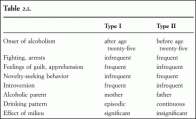The Genetics of Addiction
Type I and Type II Alcoholics
Early family studies identified two broad categories of alcoholics, who differed in the pattern of inheritance. C. Robert Cloniger of Washington University in St. Louis developed this concept when he described two clinically identifiable subgroups of alcoholics, which he termed Type I and Type II. In the 1980s diagnostic classifications reflected this dichotomy; alcohol dependence was divided into “continuous” and “episodic” types. Even though we don’t fully understand the genetic traits that go into this grouping, it has proven to be reliable.
Type I alcoholics tend to have mothers who are alcoholic, to have the onset of alcoholic drinking in their thirties or forties, to be anxious, rigid, and emotionally dependent, and to experience loss of control of the use of alcohol only after several decades of use. These alcoholics tend to engage in binge drinking rather than continuous drinking and also to be more reactive to environmental factors, which is why the term “milieu limited” is used to describe them.
Type II alcoholics tend to have fathers who are alcoholic, to have the onset of alcoholic drinking before age twentyfive, and to have problems with conduct, aggression, and impulsiveness and an inclination for novelty-seeking behaviors.
These alcoholics tend to be continuous drinkers who have a great deal of difficulty remaining abstinent for any prolonged length of time, to develop alcoholic drinking patterns very quickly after the onset of alcohol use, and to seem less affected by their environments. Because this group appears to be almost exclusively male, with the risk transmitted through fathers, it is termed “male limited.”
It has also been shown that there are physiological differences between these two groups. For example, their brain waves differ under various conditions, and they differ consistently in personality traits and temperament (table 2.1).
Trait Markers
We know, then, that you are much more likely to develop an addiction if there’s addiction in your family. But what exactly is inherited that causes this to occur? Answering that has been difficult indeed. One way of doing research is to look for trait markers, which are traits that are found to be strongly associated with the condition being studied.
 These traits might be related in some way to that condition, although they might just be linked by some other coincidental factor.
These traits might be related in some way to that condition, although they might just be linked by some other coincidental factor.
When we study relatives of alcoholics and of nonalcoholics, some differences begin to emerge, and these appear to be trait markers for alcoholism. One is called the “low response factor.” Sons of alcoholics, when given a measured dose of alcohol, will have much less of a behavioral response than sons of nonalcoholics. In fact, if we look closely at the statistics, this trait probably accounts to a large degree for the inheritance of the addiction to alcohol. Having a blunted response to the intoxicating effects of alcohol probably allows a person to drink more and also more often, especially at an early age. It is thought to increase the risk of developing an addiction to alcohol because it allows for more prolonged exposure of the brain to the addicting drug.